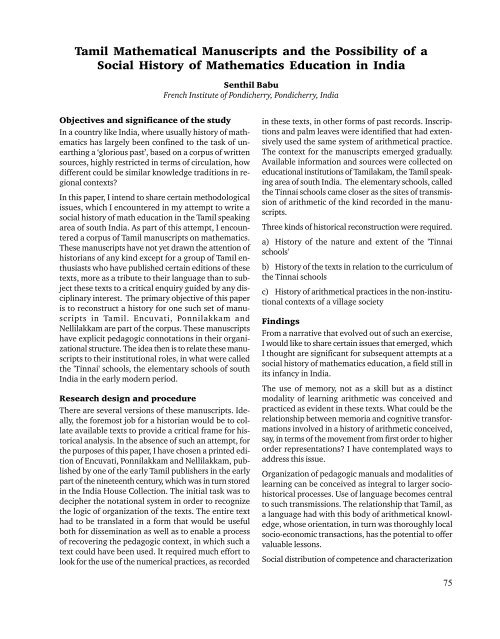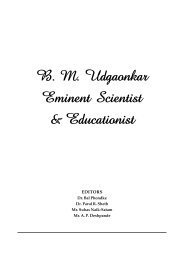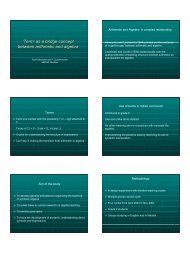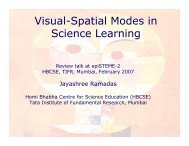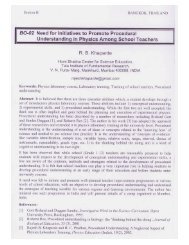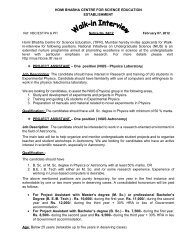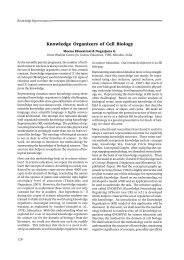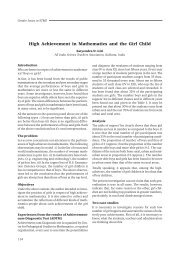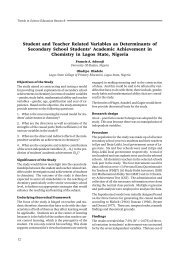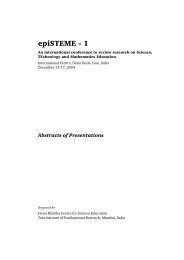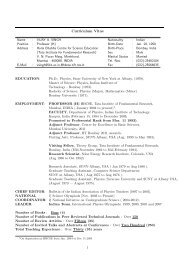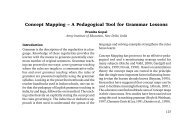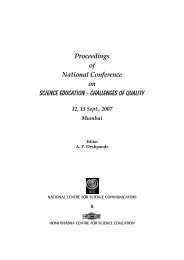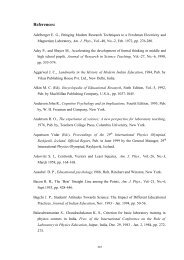Tamil Mathematical Manuscripts and the Possibility of a Social ...
Tamil Mathematical Manuscripts and the Possibility of a Social ...
Tamil Mathematical Manuscripts and the Possibility of a Social ...
You also want an ePaper? Increase the reach of your titles
YUMPU automatically turns print PDFs into web optimized ePapers that Google loves.
<strong>Tamil</strong> <strong>Ma<strong>the</strong>matical</strong> <strong>Manuscripts</strong> <strong>and</strong> <strong>the</strong> <strong>Possibility</strong> <strong>of</strong> a<br />
<strong>Social</strong> History <strong>of</strong> Ma<strong>the</strong>matics Education in India<br />
Senthil Babu<br />
French Institute <strong>of</strong> Pondicherry, Pondicherry, India<br />
Objectives <strong>and</strong> significance <strong>of</strong> <strong>the</strong> study<br />
In a country like India, where usually history <strong>of</strong> ma<strong>the</strong>matics<br />
has largely been confined to <strong>the</strong> task <strong>of</strong> unearthing<br />
a ‘glorious past’, based on a corpus <strong>of</strong> written<br />
sources, highly restricted in terms <strong>of</strong> circulation, how<br />
different could be similar knowledge traditions in regional<br />
contexts<br />
In this paper, I intend to share certain methodological<br />
issues, which I encountered in my attempt to write a<br />
social history <strong>of</strong> math education in <strong>the</strong> <strong>Tamil</strong> speaking<br />
area <strong>of</strong> south India. As part <strong>of</strong> this attempt, I encountered<br />
a corpus <strong>of</strong> <strong>Tamil</strong> manuscripts on ma<strong>the</strong>matics.<br />
These manuscripts have not yet drawn <strong>the</strong> attention <strong>of</strong><br />
historians <strong>of</strong> any kind except for a group <strong>of</strong> <strong>Tamil</strong> enthusiasts<br />
who have published certain editions <strong>of</strong> <strong>the</strong>se<br />
texts, more as a tribute to <strong>the</strong>ir language than to subject<br />
<strong>the</strong>se texts to a critical enquiry guided by any disciplinary<br />
interest. The primary objective <strong>of</strong> this paper<br />
is to reconstruct a history for one such set <strong>of</strong> manuscripts<br />
in <strong>Tamil</strong>. Encuvati, Ponnilakkam <strong>and</strong><br />
Nellilakkam are part <strong>of</strong> <strong>the</strong> corpus. These manuscripts<br />
have explicit pedagogic connotations in <strong>the</strong>ir organizational<br />
structure. The idea <strong>the</strong>n is to relate <strong>the</strong>se manuscripts<br />
to <strong>the</strong>ir institutional roles, in what were called<br />
<strong>the</strong> 'Tinnai' schools, <strong>the</strong> elementary schools <strong>of</strong> south<br />
India in <strong>the</strong> early modern period.<br />
Research design <strong>and</strong> procedure<br />
There are several versions <strong>of</strong> <strong>the</strong>se manuscripts. Ideally,<br />
<strong>the</strong> foremost job for a historian would be to collate<br />
available texts to provide a critical frame for historical<br />
analysis. In <strong>the</strong> absence <strong>of</strong> such an attempt, for<br />
<strong>the</strong> purposes <strong>of</strong> this paper, I have chosen a printed edition<br />
<strong>of</strong> Encuvati, Ponnilakkam <strong>and</strong> Nellilakkam, published<br />
by one <strong>of</strong> <strong>the</strong> early <strong>Tamil</strong> publishers in <strong>the</strong> early<br />
part <strong>of</strong> <strong>the</strong> nineteenth century, which was in turn stored<br />
in <strong>the</strong> India House Collection. The initial task was to<br />
decipher <strong>the</strong> notational system in order to recognize<br />
<strong>the</strong> logic <strong>of</strong> organization <strong>of</strong> <strong>the</strong> texts. The entire text<br />
had to be translated in a form that would be useful<br />
both for dissemination as well as to enable a process<br />
<strong>of</strong> recovering <strong>the</strong> pedagogic context, in which such a<br />
text could have been used. It required much effort to<br />
look for <strong>the</strong> use <strong>of</strong> <strong>the</strong> numerical practices, as recorded<br />
in <strong>the</strong>se texts, in o<strong>the</strong>r forms <strong>of</strong> past records. Inscriptions<br />
<strong>and</strong> palm leaves were identified that had extensively<br />
used <strong>the</strong> same system <strong>of</strong> arithmetical practice.<br />
The context for <strong>the</strong> manuscripts emerged gradually.<br />
Available information <strong>and</strong> sources were collected on<br />
educational institutions <strong>of</strong> <strong>Tamil</strong>akam, <strong>the</strong> <strong>Tamil</strong> speaking<br />
area <strong>of</strong> south India. The elementary schools, called<br />
<strong>the</strong> Tinnai schools came closer as <strong>the</strong> sites <strong>of</strong> transmission<br />
<strong>of</strong> arithmetic <strong>of</strong> <strong>the</strong> kind recorded in <strong>the</strong> manuscripts.<br />
Three kinds <strong>of</strong> historical reconstruction were required.<br />
a) History <strong>of</strong> <strong>the</strong> nature <strong>and</strong> extent <strong>of</strong> <strong>the</strong> 'Tinnai<br />
schools'<br />
b) History <strong>of</strong> <strong>the</strong> texts in relation to <strong>the</strong> curriculum <strong>of</strong><br />
<strong>the</strong> Tinnai schools<br />
c) History <strong>of</strong> arithmetical practices in <strong>the</strong> non-institutional<br />
contexts <strong>of</strong> a village society<br />
Findings<br />
From a narrative that evolved out <strong>of</strong> such an exercise,<br />
I would like to share certain issues that emerged, which<br />
I thought are significant for subsequent attempts at a<br />
social history <strong>of</strong> ma<strong>the</strong>matics education, a field still in<br />
its infancy in India.<br />
The use <strong>of</strong> memory, not as a skill but as a distinct<br />
modality <strong>of</strong> learning arithmetic was conceived <strong>and</strong><br />
practiced as evident in <strong>the</strong>se texts. What could be <strong>the</strong><br />
relationship between memoria <strong>and</strong> cognitive transformations<br />
involved in a history <strong>of</strong> arithmetic conceived,<br />
say, in terms <strong>of</strong> <strong>the</strong> movement from first order to higher<br />
order representations I have contemplated ways to<br />
address this issue.<br />
Organization <strong>of</strong> pedagogic manuals <strong>and</strong> modalities <strong>of</strong><br />
learning can be conceived as integral to larger sociohistorical<br />
processes. Use <strong>of</strong> language becomes central<br />
to such transmissions. The relationship that <strong>Tamil</strong>, as<br />
a language had with this body <strong>of</strong> arithmetical knowledge,<br />
whose orientation, in turn was thoroughly local<br />
socio-economic transactions, has <strong>the</strong> potential to <strong>of</strong>fer<br />
valuable lessons.<br />
<strong>Social</strong> distribution <strong>of</strong> competence <strong>and</strong> characterization<br />
75
<strong>of</strong> ma<strong>the</strong>matical abilities are issues that, I think, are<br />
crucial in reconstructing a social history <strong>of</strong> ma<strong>the</strong>matics<br />
in a country like India, which has deeply embedded<br />
social hierarchies. However, <strong>the</strong> history <strong>of</strong> ma<strong>the</strong>matics,<br />
has always considered its task to be: identify levels<br />
<strong>of</strong> reflection or abstraction (o<strong>the</strong>rwise characterized<br />
as meta-cognitive levels) that allow for fur<strong>the</strong>r ma<strong>the</strong>matical<br />
developments, <strong>and</strong> <strong>the</strong>n, situate secondary issues<br />
related to processes <strong>of</strong> st<strong>and</strong>ardization <strong>and</strong> institutionalization.<br />
The idea <strong>of</strong> cognitive universality <strong>and</strong><br />
social competence need to be situated in a historical<br />
context, in relation to <strong>the</strong> Encuvati manuscript corpus.<br />
The problems that I faced in integrating <strong>the</strong>se strategies<br />
will constitute <strong>the</strong> focus for my paper.


